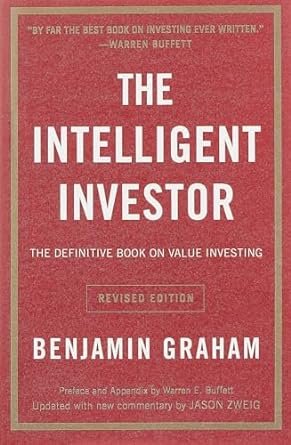Imagine if one book could set you on the path to financial success, helping you turn a modest investment into a significant portfolio over time. What if, by applying the principles from this book, you could potentially grow your wealth, protect yourself from market downturns, and secure your financial future? Sounds too good to be true? Well, it’s not.
“The Intelligent Investor” by Benjamin Graham is more than just a book—it’s a blueprint for financial success, guiding investors to lucrative returns for decades. For those new to the stock market, this book offers not just theory but practical wisdom that can translate into real financial gains. By faithfully following Graham’s principles, some readers have seen their portfolios grow by tens of thousands, if not hundreds of thousands, of dollars over their investing careers.
Whether starting with $1,000 or $100,000, “The Intelligent Investor” teaches you how to make your money work for you. In this blog, we’ll explore why this book is the best investment in your financial education and how it can help you build a robust and resilient portfolio that stands the test of time.
Why Read “The Intelligent Investor”?
1. Proven Success for Decades:
Published in 1949, “The Intelligent Investor” has stood the test of time for a reason. Generations of investors have used its principles to navigate the stock market successfully. The book’s continued relevance is a testament to the soundness of Graham’s strategies, which have helped countless people grow their wealth steadily and securely.
2. Learn from the Father of Value Investing:
Benjamin Graham is often referred to as the father of value investing. His approach focuses on investing in stocks undervalued by the market, allowing investors to buy them at a discount and benefit as their value increases over time. This method is a disciplined, rational approach to investing that helps protect against the volatility and emotional swings of the market.
3. Warren Buffett’s Endorsement:

One of the book’s most famous proponents is Warren Buffett, one of the most successful investors ever. Buffett has repeatedly praised “The Intelligent Investor,” calling it “by far the best book on investing ever written.” His investment strategies have been heavily influenced by Graham’s teachings, which he credits for much of his success. For anyone serious about investing, following the principles that guided Buffett is a compelling reason to read this book.
4. Focus on Long-Term Success:
In a world where the media often glorifies quick wins and rapid gains, “The Intelligent Investor” provides a refreshing perspective emphasizing long-term success. Graham’s approach teaches you to consider investing a marathon, not a sprint. By focusing on the fundamentals and resisting the urge to make impulsive decisions, you can build a portfolio that grows steadily over time, providing financial security for years.
5. Comprehensive Investment Education:
“The Intelligent Investor” is more than just a book about stocks; it’s a comprehensive guide to investing that covers a wide range of topics. From understanding market fluctuations to developing a sound investment strategy, Graham provides readers with the knowledge they need to make informed decisions. The book also addresses the psychological aspects of investing, helping readers manage their emotions and avoid common mistakes.
6. Protection Against Market Volatility:

One of the critical benefits of Graham’s value investing approach is its emphasis on protecting your investments during market downturns. By focusing on stocks with a margin of safety—those priced below their intrinsic value—you can minimize risk and ensure that your portfolio is better positioned to weather economic turbulence. This conservative approach is precious for beginners, who may be more vulnerable to the market’s ups and downs.
7. Timeless Principles That Apply Today:
Even though “The Intelligent Investor” was written over 70 years ago, its principles remain highly relevant in today’s market. The concepts of intrinsic value, margin of safety, and the importance of a disciplined approach to investing are just as applicable now as they were in Graham’s time. In fact, in an era of rapid technological change and global market fluctuations, the book emphasizes fundamental analysis and long-term thinking more than ever.
Key Takeaways from “The Intelligent Investor”
1. The Concept of Mr. Market:
One of the most memorable concepts introduced by Graham is the idea of “Mr. Market.” Mr. Market is a metaphor for the stock market, which Graham describes as a partner in your investing journey.
Every day, Mr. Market offers you a price at which he’s willing to buy or sell stocks. Sometimes, his prices are reasonable, reflecting the actual value of the stocks. Other times, his prices are irrationally high or low, driven by fear, greed, or market noise.
Graham’s key lesson here is that Mr. Market’s emotional swings should not sway you. Instead, you should base your investment decisions on careful analysis and understanding a stock’s intrinsic value. When Mr. Market offers you a stock at a price below its intrinsic value, it’s an opportunity to buy. When he offers it at an inflated price, it might be a good time to sell—or do nothing.
2. Margin of Safety:
The concept of margin of safety is central to Graham’s investment philosophy. It refers to the difference between a stock’s intrinsic value and its market price.
By purchasing stocks with a significant margin of safety, you protect yourself against errors in judgment, market volatility, and unforeseen events that could impact the stock’s value.
For example, if you calculate that a company’s stock is worth $50 per share based on its earnings, assets, and growth potential, but the market is offering it for $30 per share, you have a $20 margin of safety. This cushion reduces the risk of loss and increases the potential for gain, making it a critical component of smart investing.
3. The Difference Between Investing and Speculation:
Graham makes a clear distinction between investing and speculation, which is crucial for beginners to understand. Investing involves a thorough analysis of a stock’s fundamentals, including its financial health, management, industry position, and growth prospects.
The goal of investing is to generate long-term returns by purchasing undervalued assets and holding them until their value is realized.
Speculation, on the other hand, is more akin to gambling. It involves making decisions based on short-term market trends, price movements, or rumors, rather than sound analysis. While speculation can lead to quick profits, it also carries a much higher risk of loss. Graham advises investors to avoid speculation and focus on building a portfolio of solid, value-based investments.
4. The Importance of Diversification:
Diversification is another key principle emphasized in “The Intelligent Investor.” By spreading your investments across different asset classes, industries, and geographic regions, you reduce the risk associated with any single investment.
Diversification helps protect your portfolio from significant losses if one particular investment performs poorly.
Graham advises that a well-diversified portfolio should include a mix of stocks, bonds, and other assets that align with your financial goals and risk tolerance. For beginners, this approach provides a balanced strategy that can help smooth out the inevitable ups and downs of the market.
5. The Role of the Defensive Investor:
Graham distinguishes between two types of investors: the defensive investor and the enterprising investor. The defensive investor is someone who seeks a safe, steady return on their investments without taking on too much risk.
This type of investor prioritizes capital preservation and is content with moderate, long-term gains.
Graham recommends that defensive investors focus on creating a diversified portfolio of high-quality stocks and bonds, with a strong emphasis on blue-chip companies that have a proven track record of stability and growth. This conservative approach is ideal for beginners who are more interested in preserving their capital than chasing high-risk, high-reward opportunities.
6. The Enterprising Investor:
On the other hand, the enterprising investor is willing to put in more time and effort to achieve higher returns.
This investor is more active in managing their portfolio, seeking out undervalued stocks, special situations, and opportunities that require a deeper understanding of the market.
While the enterprising investor may have the potential for higher returns, this approach also comes with higher risks and requires a strong commitment to ongoing research and analysis. Graham advises that only those with the necessary knowledge, experience, and time should pursue this more aggressive strategy.
7. The Psychological Aspect of Investing:
Graham also addresses the psychological challenges of investing, which are often overlooked but can be critical to success.
He emphasizes the importance of managing your emotions, particularly fear and greed, which can lead to poor decision-making.
One of the key lessons here is to remain disciplined and stick to your investment strategy, even when the market is volatile or tempting opportunities arise. By maintaining a long-term perspective and resisting the urge to make impulsive decisions, you can avoid common pitfalls and achieve consistent, sustainable growth.
Conclusion
“The Intelligent Investor” by Benjamin Graham is a must-read for anyone serious about building a solid foundation in investing. With its emphasis on value investing, margin of safety, and the importance of a disciplined, long-term approach, this book offers timeless wisdom that can guide you through the complexities of the stock market.
Whether you’re just starting out or looking to refine your investment strategy, the principles outlined in “The Intelligent Investor” provide a roadmap to financial success that has been proven over decades. By following Graham’s advice, you can protect your investments, grow your wealth, and confidently achieve your financial goals.






One thought on “How Reading One Book Could Transform Your Financial Future?”